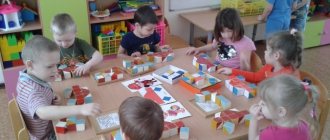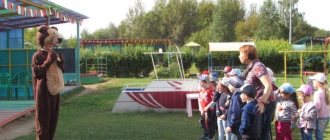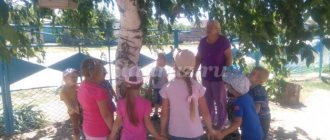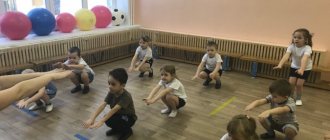Middle group. Junior preschool age. Children 4 - 5 years old
Synopsis "Dangerous objects" on educational and research activities in the middle group of compensatory orientation Synopsis of the OOD "Dangerous objects"
on cognitive and research activities in the middle group of compensatory orientation TNR Goal: Formation of
safe life skills in children Objectives : Arouse cognitive interest, emotional responsiveness to the environment….
Educational game for children 3–5 years old “Masha and dangerous objects” Goal: - formation of a cautious and prudent attitude towards situations that are potentially dangerous for humans and the natural world around them. Objectives: - to teach children to focus on dangerous objects encountered in life ; give an idea that they can cause harm...
Summary of a lesson in the middle group of a kindergarten on the topic: Safety at home
Summary of a lesson in the middle group on the topic “Safety at Home” on the topic “Mishutka’s Helpers”
Goal:
formation of conscious safe behavior.
Objectives:
Developmental: develop attention, intelligence;
Educational: • generalize children's ideas about the rules of safe behavior; • consolidate knowledge about sources of danger in everyday life; • expand children's vocabulary; Educational: foster a sense of camaraderie and empathy. Material:
illustrations “Safety at home.”
Toys and dangerous objects (an empty box of matches, an empty bottle of pills, scissors, a hammer, a toy hacksaw, a toy electric kettle and an iron) and safe objects (toys, crayons), a small tablecloth, a Teddy Bear, a ball. Progress of the lesson. Children sit in a semicircle. Educator:
Guys, look who came to visit us: Mishutka is bandaged, his paw is covered with a plaster.
- Hello Mishutka! Mishutka, what happened to you? Your head is bandaged, your paw is with a bandage…. Mishutka (teacher):
Hello guys!
Trouble! Now I’ll tell you everything, listen: “I played ball in the apartment. He played a lot of fun and threw the ball up. Mama Bear warned me that playing ball in a room is dangerous: the ball could fly into a window or a chandelier. But I didn't listen. He threw the ball so high that it broke the chandelier on the ceiling. The fragments fell down... And so I got hurt.” Educator:
Ay-ay-ay!
Guys, tell me, is it a good idea to play ball in the room? Children's answers:
No.
It is forbidden. You can break a mirror, a TV... Educator:
Well done, guys!
We have already talked about the fact that there are many dangers in every home. Let's tell Mishutka what she can play with and what it is not safe to play with. Mishutka (teacher):
Really?
Thank you. Please tell me. An outdoor didactic game “Choose a toy for Mishutka” Materials:
Non-hazardous: doll, ball, book, wax crayons, tambourine, car, dollhouse, soft toy, pyramid, board game, construction set, doll crib, tumbler (according to the number of children) ;
Dangerous items: an empty box of matches, an empty pill bottle, scissors, a hammer, a toy hacksaw, a toy electric kettle and an iron; table, small tablecloth. Progress of the game: Educator:
There are various objects on the table.
I invite all the children to come to the table, look carefully and each choose one object that is safe, with which Mishutka can play. Children examine and choose an object, place it on the table near Mishutka, inviting him to play, explaining their choice. Mishutka (teacher):
Thank you guys, you tried and helped me, and I prepared you a gift.
Ball. Educator:
Mishutka, do you know how to play ball at home correctly?
Mishutka:
Oh.
Probably not. Educator:
Guys, tell us how we play ball.
Children's answers:
We sit on the mat and skate to each other.
Mishutka is sad. Educator:
Mishutka, are you sad?
Mishutka (teacher):
I don’t have a carpet….
Educator:
Guys, I suggest you help Mishutka and make rugs for him.
Come to the tables and take your jobs. In front of you are trays on which geometric shapes are located: circles, triangles and one long strip of colored paper. I suggest you fold a strip of paper twice and cut it along the resulting lines. What shapes did you get? Children fold the strip and cut it. Children's answers:
Squares.
Educator:
Yes.
Squares. Next to the tray there is a large rectangle, this is a carpet for Mishutka. I suggest you decorate it using geometric shapes. Create a pattern on the carpet and glue all the details. Children decorate the carpet. Lay out their works close to each other on the table to make one large carpet. Mishutka examines the children’s rugs and the resulting large rug praises all the children and thanks them. Educator:
Guys, let's play ball with Mishutka on the carpet.
Let's sit on the carpet in a circle and play a very interesting game. Game "Do's and Don'ts". Educator:
I will roll the ball for you and ask you questions, and you will answer “it’s possible”, “it’s not possible”.
Guys, the one to whom the ball rolled answers. Questions: - Can I play with matches? — Climb onto the windowsill? - Play with toys in the corner? — Read books at the table? - Maybe we can play with doors? - Close and open? — Should I take sharp objects? — Knitting with grandma? — Should I bring some tasty tablets to the kindergarten and treat the kids? — Play quietly on the carpet if the soup is hot on the table? — Should I turn on the TV and iron? - Scream loudly in everyone's ears? — Should I remove the toys from the floor? Educator:
Well, well done, you completed all the tasks. I think that now you will never find yourself in a dangerous situation. And you Mishutka, do you understand everything? Will you be more careful now? Mishutka thanks the guys and leaves.
Educator:
The lesson is over. Thank you for your help. Until next time.
We recommend watching:
GCD summary on fire safety rules for the middle group GCD summary for the middle group on the topic: Safe behavior at home Summary for the middle group on safe behavior at home Entertainment on fire safety in the middle group of kindergarten
Similar articles:
Life safety classes in the middle group. Card file with goals according to the Federal State Educational Standard
Summary of a lesson on life safety in the middle group. Visiting Doctor Aibolit
Summary of a lesson on life safety in the middle group on the topic “Preparation of vinaigrette (salad)”
Long-term work plan for the formation of life safety in the middle group in 2018-2019.
Long-term work plan for the formation
Life safety in the middle group 2018-2019
Educator:
Murygina A.V.
2018-2019
Safety
is not just the sum of acquired knowledge, but the ability to behave in various situations.
Long-term planning for the formation of safe behavior skills in children is carried out in accordance with the exemplary general educational program of preschool education “From birth to school” edited by N. E. Veraksa, T. S. Komarova, M. A. Vasilyeva, which assumes the content of children’s knowledge and skills in the following sections:
- — safe behavior in nature;
- — road safety;
- — safety of one’s own life;
Goals:
- Familiarizing children with the basic principles of safe behavior in various life situations: in everyday life, in society, in nature.
- Develop the ability to independently apply them in life according to a given algorithm.
Tasks:
- To form the concept of “Fire” in children. Introduce children to the profession of firefighters. Pin
knowledge about the causes of fire and the rules of behavior when it occurs. Learn to dial the fire department telephone number, master the techniques of basic practical interaction with surrounding objects with which you can put out a fire. To instill in children self-confidence and the ability to navigate problem situations.
Develop caution and caution.
2) Classes on the topic “Dangerous objects and phenomena” will help cultivate the habit of safe
behavior and teach children to see moments of unjustified risk in everyday life. Instill the ability to competently handle objects around the child in the home environment. To acquaint children with various emergency situations, to develop psychological stability of behavior in dangerous and emergency situations. Develop a conscious, responsible and careful attitude towards your own safety and the safety of others. Develop the ability to independently use acquired knowledge and develop self-confidence.
- Take care of your health. To give children a general idea of health as a value that must be constantly taken care of. Teach children to take care of their health and the health of others, to form healthy lifestyle habits. Let children understand that many diseases do not arise out of nothing (they become infected), formulate rules that must be followed to protect themselves from infection. To familiarize yourself with the work of medical institutions, expand your understanding of different types of medicine.
4) Safe communication. Teach children to recognize situations that can be dangerous, develop the skills of correct behavior in extreme situations that threaten life and health, the ability to consciously avoid and even prevent them, develop the ability to find a constructive way out of the current situation, make a decision and react accordingly. Develop the ability to independently use acquired knowledge and develop self-confidence.
5) Introducing children to traffic rules, the responsibilities of pedestrians and road signs. Knowledge of the meaning of a traffic light on the road and all its colors separately. Know and follow traffic rules. Expand knowledge about the rules of behavior for children on the streets and roads. To consolidate the idea of the place of crossing the roadway at the zebra crossing. Rules of behavior on the roads during seasonal weather changes.
Work plan for the year
| Month | A week | The content of the work | Practical solution | |
| Games, entertainment, etc. | Fiction | |||
| September | 1 Week | Topic: “Svetik - tricolor.” Goal: to introduce children to traffic lights and the purpose of each color. Identify information children have about traffic lights. | D\i “Find the right traffic light.” Goal: to develop attention and thinking. | Looking at pictures of traffic lights. Goal: to consolidate knowledge about traffic lights. |
| 2 week | Topic: "Getting to know the street." Goal: to supplement children’s ideas about the street with new information: the houses on it have different purposes, people live in some of them. In others there are institutions - shops, a school, a post office. Cars are moving along the roadway. | Walk “Getting to know the street”. Purpose: to give a general idea of the meaning of the word street. P\i "traffic rules". Goal: develop motor activity, reinforce traffic rules. | Looking at an album of the streets of our city. | |
| 3 week | Topic: “Pinocchio goes to the circus” (game exercise). Goal: to teach children to behave correctly in public transport. | S/r game "Trolleybus" Goal: To enrich the gaming experience by combining individual actions into a single storyline; develop interest and desire to participate in the game. | A fairy tale about: “a naughty bunny and bear cubs” Reading the poem “My Street” by S. Mikhalkov. | |
| 4 week | Topic: "Dangerous objects." Goal: To clarify children’s ideas about sources of danger at home and about the rules for using household appliances. | D/i “Find pictures” Goal: To teach children to find dangerous objects in the picture. | Looking at illustrations. Goal: to conduct a conversation about the sources of danger at home, about the rules for using household appliances. | |
| October | 1 Week | Topic: “One, two, three, what can be dangerous - find it.” Goal: to consolidate an understanding of the sources of danger at home, on the street, and about the rules for using household appliances. | D/i “One, two, three, find what could be dangerous.” Goal: to consolidate knowledge about sources of danger at home and on the street. | |
| 2 week | Topic: “Attention road.” Goal: to give children an idea of how to properly exit public transport, enter the front door and exit the back door. | Walk “Who are pedestrians?” Purpose: to give an idea of underground and overland passages; consolidate knowledge of how to cross the street correctly. D/i: “Street” Goal: Learn to name parts of the street (road, sidewalk, houses, traffic lights, pedestrian crossing). | Reading the book “Road Rules”, V. Kozhevnikova, A. Severny. "Traffic light". Examination of the series of pictures “Our Street”. | |
| 3 week | Topic: “Fire is a friend. Fire is the enemy." Goal: To expand children's knowledge about the rules of safe behavior with fire; introduce children to the firefighter uniform. | P/i "Fire in the hearth." Goals: to develop reaction speed, dexterity, spatial orientation, attention, endurance; to form a sense of courage, discipline, will and desire to win, as well as a culture of behavior in everyday life. | Looking at illustrations depicting a firefighter uniform and looking at illustrations on the topic "Fire" Goal: to consolidate knowledge about the causes of fire and its consequences. | |
| 4 week | Topic: “How to keep your skin healthy?” Goal: Expand children's understanding of the protective properties of skin and skin care skills. | D/i “A doll came to visit us.” Goal: develop hygiene skills. D/i "Good - bad." | ||
| November | 1 Week | Topic: “Every citizen knows this number – 101”! Purpose: To familiarize children with fire safety rules; form an idea of behavior in the event of a fire threat; cultivate a sympathetic attitude towards the victim. | Di “What burns, what doesn’t burn” - introduce flammable and non-flammable materials P/i "After the fire" Goal: to develop the ability to wind a cord onto a reel. | Reading the work "Cat's House." Goal: to clarify how the heroes managed to put out the fire. |
| 2 week | Topic: “Svetik - tricolor” - according to a traffic light signal. Goal: to consolidate existing ideas about a traffic light, its purpose and principle of operation; develop interest in traffic rules; introduce children to the work of a traffic controller on the street. | S/r game “City Trip”. Goal: teaching children to implement a game plan to create transport from a large builder, to learn how to play with the construction. | "Three-eyed friend." Making riddles about traffic lights. Reading the poem by Y. Pishumov “Look, the guard is standing on our pavement.” Purpose: to introduce the author’s works. | |
| 3 week | Topic: “Travel to the country “My Health”. Goal: to clarify children’s knowledge of what parts the human body consists of, to talk about the role of the senses. | P/n “ | Looking at illustrations of a person. Purpose: to give an idea of the senses and why they are so important. | |
| 4 week | Topic: “Fire in the apartment.” Goal: to introduce children to the profession of a firefighter; form an idea of behavior in the event of a fire threat. | D/i: “1, 2, 3 – find what could be dangerous” Goal: to clarify children’s knowledge about sources of danger in the house, to develop intelligence and attention. | Reading S. Marshak “Fire”. Purpose: to introduce the author’s works. | |
| December | 1 Week | Topic: “Winter fun” (safety rules during winter games). Goal: To teach how to use a sled and play snowballs. | P/i “It’s snowing” Goal: to teach how to correlate your own actions with the actions of the participants in the game; exercise children in running, making turns around themselves. | Looking at the illustrations, the painting “Well, I went for a ride...”. Goal: to teach children to follow the rules while sledding and playing in the snow. |
| 2 week | Topic: “Personal safety at home.” Goal: Goal: continue to introduce children to the rules of behavior at home. | Table theater "The Wolf and the Seven Little Goats". Goal: To promote the emergence of games on the themes of Russian folk tales, to develop communication skills. | Reading poetry G. Shalaeva, O. Zhuravleva. "Don't open the door to strangers." | |
| 3 week | Topic: "Safety at home." Medicines and household chemicals. Purpose: To clarify children’s ideas about dangerous objects in everyday life that should not be played with. | D/i “Find your vitamin.” Goals: to teach orientation in space; distinguish the primary colors of the spectrum. | T. A. Shorygina “Remember, kids, pills are not candy” Goal: to develop children’s knowledge that they should not take medications without the permission of adults. | |
| 4 week | Topic: “Personal safety on the street.” (Not everyone you meet is a dear friend). Goal: to teach to see dangerous situations on the street, to introduce the rules of behavior with strangers. | D/i “Observer” (description of a person, signs, what he looks like). Goal: to develop attention, memory, logical thinking. | Reading the fairy tale “Little Red Riding Hood” by Charles Perrault. Purpose: to introduce the author’s works. | |
| January | 2 week | Topic: "Caution - Electrical Appliances." Goal: to teach how to use electrical appliances correctly. | D/i “Find pictures” Goal: To teach children to find dangerous objects in the picture. | Reading fiction: O. Bedarev “If”. Purpose: to introduce the author’s works. |
| 3 week | Topic: “Boulevard of Road Signs.” They don’t see it themselves, but point it out to others. Goal: Continue to familiarize children with road signs and their purpose; learn to remember signs; draw special attention of children to the zebra crossing pedestrian markings. | D/i “What sign is this?” D\i “Find out the sign, whether the sign was placed correctly.” Goal: consolidate knowledge about road signs. | Reading fiction by G. Yurmin “The Curious Mouse.” Goal: acquaintance with the author’s works. | |
| 4 week | "Heroic Professions" Goal: to introduce children to heroic professions: firefighters, rescuers. | S/r game “In the trampoline” Goal: To expand children’s understanding of the work of a doctor; develop the ability to correctly use the attributes of the game; develop children’s communication skills with adults and each other; enrich children's life experiences. | Reading S. Marshak “The Story of an Unknown Hero.” Goal: to continue to introduce the author’s works. | |
| February | 1 Week | Topic: “Hurry, don’t rush”! Purpose: to introduce children to some rules for the movement of pedestrians on the street, to give the concepts: pedestrian, ground, underground passage, roadway, sidewalk; teach children to pay attention to road signs; learn how to behave properly on the street. | Walk down the street. S/r game “You are a pedestrian today” Goal: to introduce children to a pedestrian crossing, to help them remember what it is for, and where it can be seen. | Reading fiction: S. Mikhalkov, “Walking carefully.” Purpose: to introduce the author’s works. |
| 2 week | Topic: “Riddles on fire safety rules.” Purpose: to clarify children’s knowledge about fire safety rules. | Verbal - game "Find the right solution." Goal: consolidate knowledge about fire safety | Reading poems on fire safety. Goal: teach children to follow fire safety rules. | |
| 3 week | Topic: “In the world of dangerous objects.” Purpose: to consolidate ideas about sharp objects, piercing and cutting objects, to warn against accidents in everyday life. | D/i “Find pictures” Goal: To teach children to find dangerous objects in the picture. | Reading a fairy tale by T. A. Sharygin. “Scissors and spools are not toys” Goal: to continue to introduce the author’s works. | |
| 4 week | Topic: “Travel to the country “My Health”, “How does my body work?” Purpose: to give initial ideas about the structure of the human body and the functions of its main organs. | D/i “Collect in your cart” Goal: to promote the formation of ideas about the benefits of natural products, the need to eat fresh fruits and vegetables, and to consolidate the classification of vegetables and fruits. | Review of the album "Man". Purpose: to give general ideas about a healthy lifestyle. | |
| March | 1 Week | Topic: “If there is no traffic light on the street.” Purpose: To familiarize children with the rules of crossing the road where there is no traffic light; establish rules of behavior for pedestrians on the street; continue to teach children to pay attention to road signs; cultivate a caring attitude towards everything that surrounds us: forest, buildings. | D/i “Did Dunno do the right thing.” Goal: to develop logical thinking, memory, imagination. | Memorizing S. Mikhalkov’s poem “Walking Carefully.” Goal: to continue to introduce the author’s works. |
| 2 week | Topic: "Ambulance" Purpose: to introduce children to the telephone number 103; teach how to call an ambulance; to form an idea of the profession of an emergency doctor, to cultivate respect for the work of an emergency doctor. | Simulation of game situations on the topic of first aid. Goal: to form an idea of the medical profession. | ||
| 3 week | Topic: “Fire Safety Quiz.” Goal: to clarify and consolidate children’s knowledge of fire safety rules. | S/r game “Young firefighters”. Goal: to form an understanding of the tools that firefighters use. | Examination of the painting “Firefighting”. Goal: to consolidate children’s knowledge about the causes of fire. | |
| 4 week | Topic: “Safety when communicating with animals.” Goal: familiarization with the rules of safe behavior with animals. | D/i: “Think and answer” Goal: To teach how to correctly answer questions about the rules of contact with animals. | Looking at the illustration "Pets". Goal: consolidate knowledge about domestic animals. | |
| April | 1 Week | Topic: “Modes of transport.” Goal: fixing types of urban transport, rules of behavior in it; give an idea of the characteristics of the movement of a trolleybus, bus, tram; the trolleybus moves using electricity; the bus is refueling with gasoline, the tram is moving on the rails. | D/i “Think and Say” (answers to questions) Goal: To teach how to correctly answer questions asked about the rules of behavior in transport. | Reading of S. Mikhalkov’s poem “Cyclist”. Goal: to continue to introduce the author’s works. |
| 2 week | Topic: “The kitchen is not a place for games.” Goal: to teach to notice dangerous objects in the kitchen: hot stove, cutting objects; explain to children why they should not play in the kitchen. | S/r game “Family. Cooking lunch" Goal: To develop children’s ability to translate life experience into a conventional game plan; promote the development of independent play of the child, the search for new gaming tasks and ways to solve them; develop creative and communication abilities. | Reading a story Yu. S. Vasilyuk. "In the kitchen" Goal: to consolidate children's knowledge about dangerous objects in the kitchen. | |
| 3 week | Topic: “Through the streets of our city.” Goal: to consolidate specific knowledge about the rules of behavior on the streets of the city and town; clarify knowledge of who regulates traffic on the streets; consolidate knowledge of road signs. | S/r game “City Trip”. Goal: teaching children to implement a game plan to create transport from a large builder, to learn how to play with the construction. | Looking at illustrations. Goal: to expand children’s knowledge about city streets, to teach them to identify roads, sidewalks, and houses. | |
| 4 week | Topic: “Microbes and viruses.” Goal: to teach children to take care of their health and avoid situations that are harmful to their health; cultivate the habit of observing personal hygiene rules. | The plot game “I will help myself, I will save my health.” Target: establish the rules of personal hygiene. | Reading a fairy tale by K.I. Chukovsky "Moidodyr" Purpose: to introduce the author’s works. | |
| May | 1 Week | Topic: “Introduction to some rules for the movement of pedestrians on the street.” Goal: to introduce children to some rules for pedestrians, to the concepts: pedestrian, ground crossing, underground crossing. | D/i “Guess the sign” Goal: To teach children to find and show the “Pedestrian crossing” sign among other unfamiliar signs. | Looking at illustrations. Goal: to expand children’s knowledge about city streets, to teach them to identify roads, sidewalks, and houses. |
| 2 week | Topic: "If you are lost." Goal: to bring children to the understanding that for help they need to turn not to any adult, but to a policeman, a seller, or a military man; Help children understand the importance of knowing their address and telephone number. | Dramatization game (sketch) r.n. fairy tales "The cat, the rooster and the fox" Goal: To promote the emergence of games on the themes of Russian folk tales, to develop communication skills. | Funny story M. Manakova. "Someone else's yard" Goal: tell children how the hero of the story got lost in someone else's yard. | |
| 3 week | Topic: “Sunstroke” Goal: to teach children the rules of behavior in the hot summer. | S/r game “Walk in the forest” Goal: To develop interest and desire to participate in the game; enrich children's gaming experience; to form the ability to form emotional contact with comrades; stimulate children's creative activity in play. | Looking at illustrations about the rules of behavior in the hot season. Purpose: to give a general idea of how to behave in hot weather. | |
| 4 week | Topic: “Sun, air and water are our best friends!” Target: familiarization with the rules of behavior and safety near bodies of water and in the park. | P/n “ | Reading a fairy tale T. Yufereva. "Rain and Sun" Goal: to consolidate children's knowledge about the benefits of sun and rain in nature. | |




